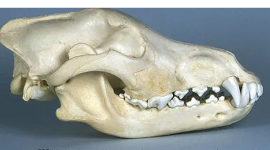
Brachycephalic Obstructive Airway Syndrome
What is BOAS?
BOAS is a condition that affects dogs with shortened, flat noses (brachycephalic breeds). These dogs are born with a compressed skull shape, which can cause breathing difficulties due to several anatomic abnormalities in the upper airway.
Commonly affected breeds include:
Pugs
English Bulldogs
French Bulldogs
Boston Terriers
Associated anatomic abnormalities include:
Stenotic nares: Stenotic nares are abnormally narrow nostrils that restrict the airflow into the nose.
Figure 1: The skull of a pug, a brachycephalic breed, and the skull of a German Shepherd.(https://www.kentdalevets.co.uk/services/soft-tissue-surgery/brachycephalic-obstructive-airway-syndrome-boas)
Elongated and thickened soft palate: The soft palate divides the nasal passages from the throat. In brachycephalic dogs, this is often thickened and elongated causing obstruction of the nasal passages and the larynx. The larynx is the opening into the trachea which funnels air to the lungs .
Aberrant nasal turbinates: The nasal turbinates are scroll like bones within the nasal cavity that are covered by soft tissue and help to warm and humidify the air as it is breathed. When the nasal turbinates extend beyond the nasal cavity, they can cause airflow restrictions.
Everted laryngeal saccules: The laryngeal saccules are small pouches of tissue within the larynx. When airflow is restricted, the negative pressures generated in the upper airway cause the saccules to become swollen and evert into the larynx.
Hypoplastic trachea: A hypoplastic trachea is a trachea (windpipe) that is smaller than normal and commonly found in brachycephalic dogs.
Laryngeal collapse: As dogs age, the chronic stresses on their upper airway can lead to softening and collapse of the larynx, worsening the airway obstruction.
Signs and Symptoms of BOAS include:
Snoring/snorting
Loud/noisy breathing
Difficulty breathing
Gagging
Sleep apnea
Regurgitation
Exercise intolerance
Diagnosing BOAS
Stenotic nares can be diagnosed on visual examination. The other components of brachycephalic syndrome require a sedated airway exam performed by a veterinarian familiar with this syndrome. Bloodwork will be performed to check your dog’s overall health and chest radiographs are recommended to look at the size of the trachea as well as to evaluate for other problems that are common in brachycephalic dogs (i.e. hiatal hernias and aspiration pneumonia).
A CT scan is helpful to evaluate the thickness of the palate and to look for evidence of aberrant nasal turbinates.
Treatment
Some components of brachycephalic syndrome can be improved with surgery, however some cannot. Stenotic nares can be opened by removing a wedge of tissue from the nostril. A long soft palate can be shortened, or a long and thickened soft palate can be thinned and shortened at the same time. Everted saccules can be removed if severe. Aberrant nasal turbinates can be removed using a laser procedure (LATE); however, this is not commonly performed. All of these approaches attempt to reduce the physical obstruction of airflow.
Laryngeal collapse is not a correctable condition, however dogs with end stage laryngeal collapse may benefit from a procedure called a permanent tracheostomy where a permanent opening is made through the neck into the trachea, bypassing the upper airway completely. (Note: laryngeal collapse is not the same as laryngeal paralysis which can be mitigated with surgery.)
All of these procedures are best performed by a board-certified surgeon familiar with this disease.
What is recovery like?
After surgery your pet will need to have activity limited for about 10-14 days. No running, jumping or playing should be allowed. Pain medications will be prescribed to be given for several days after surgery and in some cases gastro-protectants, anti-inflammatories or antibiotics will also be sent home.
We recommend transitioning to a harness for walking instead of a traditional collar with leash if you haven’t already. This should be a life-long change as it will remove a source of pressure to your pet’s windpipe (trachea).
Immediately post-surgery, your pet may be drowsy, uncoordinated or nauseous. Unless otherwise instructed, we normally recommend the following for food and water:
Water Reintroduction: Offer a small amount of water 30 minutes to 1 hour after arriving. If there are no signs of nausea and water is kept down, more can be offered in small amounts. You may resume normal water access the following day,
Food Reintroduction: Wet or dry food softened with water is advisable for the first week post-op. Offer 1/2 their normal feed 2 hours after arriving home. If there are no signs of nausea and food is kept down, you may resume normal amounts the following day.
Detailed postoperative instructions will be provided to you after the surgery that outline medications, and incision care for visible incision sites. Bandages on the IV catheter site can be removed once you get home. It is normal for some bruising and swelling to occur. Please notify us or your veterinarian if you observe:
Difficulty breathing
Increased redness/bruising over time
Odorous or pus-like discharge - this may be from the mouth or nostrils.
Opening of the incision site
Increased swelling
Vomiting
Signs of acute pain.
Prognosis
Short term complications associated with surgery include bleeding, airway swelling that may require a temporary tracheostomy, aspiration pneumonia, and death.
Brachycephalic dogs will generally improve with surgery, however not all dogs will. It is important to know that even with surgery it is not possible to give your dog a completely normal airway. Your dog may continue to have increase respiratory noise and should be protected from excessive heat and overexertion. Dogs that have surgery when young (less than 2 years of age) generally have a better prognosis and it is not uncommon for the procedure to be recommended at time of spay or neuter. Dogs that are severely affected or are older are expected to be at a higher risk of complications during surgery and will not improve to the same degree after surgery that a younger dog does.



